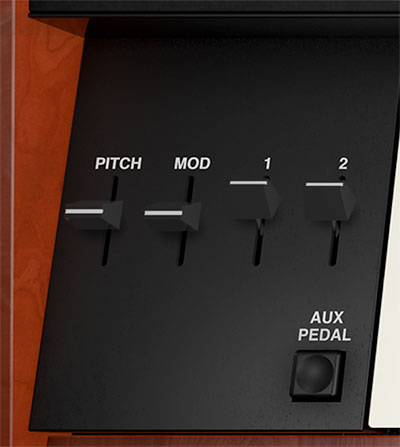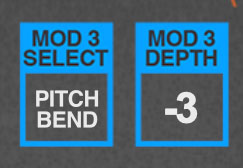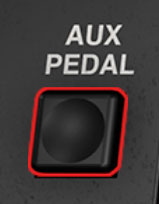The left-hand control section of the original Chroma was is a little different than the standard pitch and mod wheel setup. Its left-hand controls consisted of simply of two spring-loaded, self-centering arced "paddle" controls, colorfully named "1" and "2." These were included as sources in most of Chroma's mod source menus, allowing them to be configured as standard pitch and mod controls, or much more.
In Cherry Audio's Chroma, we made some changes and added a few controls to better accommodate modern MIDI/USB controllers.
PITCH- The PITCH paddle operates like most pitch wheels you've encountered, but with one difference. Unlike most synths, its control signals are not hard-wired to the oscillators; it needs to be set up in a mod bus to function. The good news is that it's already set up in the vast majority of Chroma's presets (including the default patch that loads when the NEW button at top left.) The other good news is that the pitch paddle controller signals can be multiplexed to numerous simultaneous destinations.
One more quirk we should mention - the Chroma pitch wheels operated backwards from most, that is, pushing up lowered pitch, and pulling it back raised pitch, so any of the original patches will work this way. If you'd like to modify a patch to be standard "wheel-forward-moves-pitch-up," here's how:
In the PITCH section, locate the mod bus that pitch bend is currently assigned to and invert the MOD DEPTH setting. In the example above, you'd set MOD DEPTH to +3 instead of -3.
Keep in mind you'll most likely need to do this for all layers - A and B if you're just using Chroma, or A, B, C, and D if you're using a double Chroma+Expander patch. (You can streamline the process a bit by clicking the EDIT A+B or EDIT C+D in the EDIT MODE section.)
MOD- Like the PITCH paddle, the MOD paddle is a mod source in most of Chroma's mod source menus. Unlike most mod wheels though, it's a spring-loaded and self-centering like the pitch wheel. When used with a hardware MIDI/USB controller with a standard bottom-to-top (i.e. not centered) mod wheel control, it moves onscreen from middle-to-top position. This results in positive-only mod values, just like a standard mod wheel. That said, it can output negative values either by moving the control with onscreen with the mouse/trackpad, or by assigning a different hardware MIDI controller (by right-clicking, selecting MIDI Learn, and moving the desired controller).
To configure mod wheel-controlled vibrato or tremolo, check out Using Amplitude Mod to Set Up Mod-Wheel Controlled Vibrato, Tremolo, etc. toward the bottom of the page in the Sweep section.
1/2- Unlike the pitch and mod sliders, these are not "spring loaded" and will remain at whatever position they're set to. 1 and 2 paddle positions are stored with saved patches.
Aux Pedal button- The original Chroma included a fanciful piano-style dual-pedal foot controller (they're probably $27,000 on Reverb these days). The right-side pedal was a standard sustain pedal; the left-side pedal was referred to as the Auxiliary Pedal, and it has its own dedicated mode button in the CONTROL section. It's an on/off pedal that performs a couple of nifty real-time functions. In the name of staying true to the original Chroma's functionality, we wanted to retain it .
The problem we ran into is that many MIDI/USB controllers don't have additional pedal input jacks (the fancier Arturia and Native Instruments controllers do). The other problem is that the MIDI controller # for secondary pedals isn't standardized, so we couldn't set aux pedal to a fixed MIDI controller # the way we normally would with a pitch bend or mod controller.
The solution was to add a corresponding AUX PEDAL momentary button in the left-hand controls section. This lets you assign any hardware MIDI controller to the button - an actual pedal, or a button on a MIDI/USB controller, and it's easy to do thanks to Cherry Audio's super simple right-click MIDI assign function (right-click the AUX PEDAL button, select MIDI Learn from the menu, whack the button/pedal/MIDI yogurt maker/etc., controller is assigned).
We've replicated the Aux Pedal's functions, which are as follows:
Latch Pedal- Allows specific keyboard notes to be held while playing other non-held notes to be concurrently played.
Note Gate- Disables or enables the entire layer using the pedal. This is used with dual-layer patches to bring in or mute one of the layers.
Poly Chord Buffer- This lets you "enter" a chord, then trigger it using the left pedal.
For more info about the preceding Latch Pedal, Note Gate, and Poly Chord Buffer functions, please see the Parameter Program/Control/Aux Pedal Mode section.
Glide Enable/Disable- The Aux Pedal acts as a momentary control when Aux Pedal Enables Glide is checked in the GLIDE SHAPE menu. For more info, please see the Left-Hand Controls/Aux Pedal Button section.


